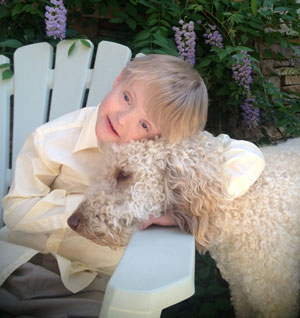Animals have long been used to provide unique services for individuals who need specialized assistance in some way. In addition to providing such basic services as security and protection, animals have been used to provide emotional and psychological comfort and support to people. Service Dogs have proven to be incredibly effective in ways that other approaches have not, and these animals can make a profound difference in the lives of so many individuals and families in need.
The increasing incidence of autism spectrum disorders has resulted in an increase in therapies designed to treat this condition. A recent development has been the training of Service Dogs to specialize in working with persons with autism spectrum disorders. Proponents of “Service Dogs” assert that these dogs can support the unique challenges of persons on the spectrum.
Service Dogs provide a “calming presence” that “can minimize and often eliminate emotional outbursts.” Some advocates believe that such dogs can provide “focus through which the child can interact with other children. This helps increase the opportunity for the child to develop social and language skills.” Burrows, et al. (2008a) believe that Service Dogs can positively influence children with autism in the areas of arousal and sensory stimulation, improving concerns in these areas. In addition, dogs can function as a “transitional object,” allowing the child with autism to first bond with the dog, an easier creature with which to do so, and this may eventually increase bonding with humans.
As with many strategies and treatments when it comes to autism therapy, one must ask about the evidence of effectiveness of Service Dogs. Literature has been released that describes two primary positive outcomes:
· Enhanced physical safety and security
· Enhanced social, learning, and emotional improvements
When reviewing the literature for research on the effect of autism dogs, there are many testimonials and case studies. Most of the research done on this topic consists of qualitative research, involving interviewing as the means for collecting data.
Studies show support for the notion that Service Dogs provide increased physical safety and security. Forexample, Burrows and Adams (2005) and Burrows, Adams, and Millman (2008a) reported that parents consistently claimed that the dogs prevented children from bolting and running away. Parents relaxed more during bedtime knowing that the dog would alert them should the child with autism leave the bed or exhibit some other potentially dangerous behavior. Because of the dog’s ability to physically prevent the child with autism from behaving in a dangerous way, parents felt more in control and calmer. Parents reported immediate satisfaction and reduction in concerns about safety issues.
Some parents noticed new skill development. For example, after being with their dogs for a period of time, some children began regulating walking pace and developing improved motor skills and control. Burrows, et al. (2008a) found that some of their participants began learning dog-care tasks (e.g., feeding the dog by taking lid off food container; putting food in bowl; putting bowl on floor; commanding dog to eat).
Additionally, motor skills improved in some children who learned to pet the dog. The authors also found that, according to parents, the children exhibited decreased anxiety, were calmer, and engaged in fewer tantrums and other disruptive behaviors. Some parents even reported improved bedtime routines, and that the children in general appeared happier.
Using a different approach; researchers investigated the impact of such dogs on the mood and social abilities of children with autism. The researchers systematically varied three different conditions consisting of a simple toy, stuffed dog, and real dog. They found that the participants demonstrated greater positive mood and “focus” on the environment when in the presence of the Service Dog.
The reason that Service Dogs are often effective in helping treat and look after children with autism is that they have an uncanny ability to bond with people, including children, on a deep level. While many children with autism have trouble articulating themselves, this is not necessary with a dog. This type of connection, when paired with proper Service Dog training, is what makes dog treatment for autism so effective.
Service Dogs are consistently showing promise as an effective autism treatment method in children. However, like many treatment methods, there is still ongoing research and as with most healthcare treatment options, a service dog is no guarantee for improvement in condition. However, it can be an vital, remarkable, and cost-effective solution to a number of difficulties for a child with a disability. The key is to evaluate the situation as carefully as possible, keeping expectations realistic and conditions flexible.
TJ Smith
Service Dog Trainer
www.CompanionTraining.com
References:
· Burrows, K. E., & Adams, C. L. (2005). Evaluating the benefits of service dogs for children with autism spectrum disorders. Retrieved on October 21, 2001 at www.cnaf.net/documents/NationalServiceDogsStudy.pdf
· Burrows, K. E., Adams, C. L., & Millman, S. T. (2008a). Factors affecting behavior and welfare of service dogs for children with autism spectrum disorder. Journal of Applied Animal Welfare Science, 11, 42-62.
· Burrows, K. E., Adams, C. L., & Spiers, J. (2008b). Sentinels of safety: Service dogs ensure safety and enhance freedom and well-being for families with autistic children. Qualitative Health Research, 18(12), 1642-1649.



